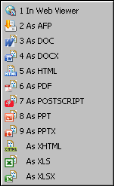In Actuate BIRT Designer Professional or Interactive Viewer, you can choose to render BIRT reports in several different formats, as shown in Figure 30-1.
|
Figure 30-1
|
|
|
HTML - HyperText Markup Language document, a standard format used for creating and publishing documents on the World Wide Web
|
|
|
POSTSCRIPT - A page description language document for medium- to high-resolution printing devices
|
|
|
XHTML - Extensible Hypertext Markup Language document, the next generation of HTML, compliant with XML standards
|
If you need to export your document to a format not directly supported by Actuate, such as CSV and XML, you need to develop a custom emitter. Actuate supports using custom emitters to export reports to custom formats. After a system administrator places custom emitters in the designated folder in Information Console or iServer, and registers the emitters with iServer, he must restart the product. Users then are able to use the emitters as output formats when scheduling BIRT report jobs in iServer or exporting BIRT reports in Information Console. Custom emitters are also supported as e-mail attachment formats.
iServer uses the custom emitter format type as a file extension for the output file when doing the conversion. When you develop custom emitters, always use the same name for a format type and an output file extension type. Management Console and Actuate Information Console for iServer display the options of each emitter for the user to choose when exporting a report.
The Integrating and Extending BIRT book, published by Addison-Wesley, provides detailed information about how to develop custom emitters in BIRT.

